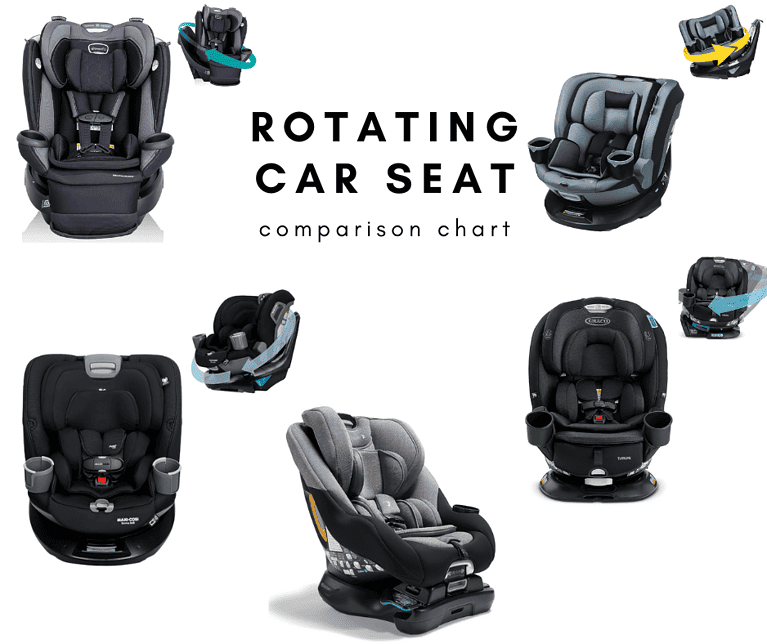How to Pick the Best Car Seat in 2023: A Beginner’s Guide

Every parent wants the best for their child, especially when it comes to safety. One of the more important purchases you’ll make is the car seat.
When I was first looking for a car seat I was overwhelmed with all of the different kinds and options and wasn’t sure what I should be looking for in the ideal car seat.
This guide is here to simplify that process for you and help you pick the best car seat for your baby.
I use affiliate links in some blog posts. If you click through and make a purchase, I earn a small commission at no extra cost to yourself. Thank you for your support.
Know the Different Types of Car Seats: An Overview
Before you buy a car seat, it’s essential to understand the different types available:
- Infant Car Seat: These seats are designed specifically with the littlest passengers in mind. Made explicitly for newborns and babies, they provide a snug and secure environment, typically suitable for babies up to 20-35 pounds (depending on the model). They are always rear-facing, which is the safest position for infants. Another advantage? Many infant car seats are compatible with strollers, allowing for a seamless transition from car to on-the-go. (I got the Uppa Baby Mesa car seat and having it click in to my Uppa Baby stroller was so convenient.)
- Convertible Car Seat: As the name suggests, these car seats are all about flexibility. Initially set up as a rear-facing seat to accommodate infants, they can later be converted to a forward-facing position as your child grows. This longevity makes convertible seats a cost-effective option for parents who are looking for a longer-term solution. Most convertible seats will carry a child from birth until they’re ready for a booster seat, accommodating weights from 5 up to 65 pounds or more.
- Rotating Car Seats: The latest in car seat technology, rotating car seats, are an answer to many parents’ struggles of getting their child in and out of the car. With the ability to swivel or rotate, parents can turn the seat towards the door, buckle in their child, and then rotate the seat to either a rear or forward-facing position. This feature minimizes awkward reaches and bends for parents, especially in tighter car spaces. Additionally, the rotating feature ensures a longer usage span as it often combines the features of both rear and forward-facing seats, accommodating the growth spurts of your little ones.
- Booster Seat: When your child has outgrown the limits of their forward-facing seat, it’s booster time. Booster seats are designed to “boost” your child up so that the vehicle’s regular seat belt fits them correctly, typically when they are between 40 and 80 pounds. There are two main types: high-back boosters, which provide head and neck support and are ideal for cars without headrests, and backless boosters, which are more portable and better for vehicles with high back seats or adjustable headrests.
Knowing the nuances of each type will help ensure you select the right car seat tailored to your child’s needs and your lifestyle.
Some individual factors to consider is how big is your car? If you travel, is the car seat a good choice for flying? How heavy is the car seat?
Start with the Basics: Height and Weight

Every type of car seat is designed to fit a specific range of height and weight. This isn’t just a manufacturer’s suggestion but is based on rigorous safety tests and studies aimed at ensuring the utmost protection for children of different ages and sizes.
When we talk about a car seat’s height and weight range, we’re essentially discussing the scope of protection it offers. Car seats undergo various crash tests, and their safety features – be it the structure, padding, harness system, or anchoring mechanism – are all crafted to optimally protect children falling within that specified range.
Before venturing into car seat buying, it’s important to have updated measurements of your child’s height and weight. Children grow at varied rates, and even a few inches or pounds can significantly influence how well they fit into a car seat. Using a car seat that’s not suitable for your child’s specifications can compromise its safety effectiveness.
As your child continues to grow, these measurements act as a reference point. By regularly comparing their growth with the car seat‘s specifications, you can determine when it’s time to transition to the next type of seat, ensuring that your child always has the best possible protection during every car ride.
The simple act of measuring your child’s height and weight is a key step in the journey of car seat safety. It guarantees that the seat you choose is not just any seat but the right seat for your child at their current stage of growth.
Car Seat Duration Matters: Rear-facing vs. Forward-facing
Experts often emphasize the importance of rear-facing car seats and with good reason. These seats have been shown to offer the best protection for younger children in the event of a collision. Therefore, keeping your child in a rear-facing seat for as long as possible is highly recommended, usually until they outgrow the height and weight limits set by the car seat manufacturer.
But what happens when your child outgrows their initial infant seat? This is where convertible car seats come into the picture. Designed with longevity in mind, these seats start as rear-facing to continue offering that enhanced protection for infants and toddlers. As your child grows and reaches the seat’s height and weight limit for the rear-facing position, the seat can be turned to face forward, adapting to your child’s growing needs.
The dual-functionality of the convertible seat ensures that your child benefits from car seat safety features for a more extended period, without the need to frequently switch between different seats. The transition between rear and forward-facing is smooth and keeps your child’s comfort in mind.
Research vs Recommendations on How to Pick the Best Car Seat

In the age of information, word of mouth and personal recommendations remain some of the most trusted sources when deciding on products. This is especially true when it comes to essentials for your child, like car seats. While the experiences of friends and family can provide valuable insights, it’s paramount to not solely rely on them.
Every child, car model, and family’s needs can be unique. Therefore, it’s essential to do your own research to make sure that the car seat you’re considering is the best fit for your specific situation.
Beyond safety, practicality plays a significant role in day-to-day use. Here, online reviews can be a treasure trove of information. Dive into product reviews on retail websites, parenting forums, and dedicated car seat review platforms. Parents from diverse backgrounds share their hands-on experiences, and you’ll often find feedback on aspects you hadn’t even considered.
From ease of installation – a factor that can save you immense time and frustration – to the comfort levels, and the car seat’s durability over time, product reviews provide a comprehensive understanding of the product’s real-world performance.
Furthermore, in this digital era, there are numerous video reviews and tutorials available online. These can be incredibly helpful as they often provide a visual guide to installation, adjustment settings, and real-time usage, giving you a fuller picture of what to expect.
While recommendations provide a good starting point, a thorough personal investigation helps you make the most informed decision for the safety and comfort of your child.
Making an Informed Choice
- Test Before Buying- The Fit Factor: You wouldn’t buy a pair of shoes without trying them on first, right? The same principle applies when investing in a car seat. While all seats are designed to meet certain safety standards, not every seat will be a perfect fit for every vehicle. Whenever possible, it’s a wise decision to test the car seat in your own vehicle before making the purchase. This hands-on approach allows you to determine how well the seat integrates with your car’s design, ensuring it sits flat, is securely anchored, and doesn’t wobble or tilt. A snug and secure fit is paramount to the seat’s safety efficacy.
- Check for Recalls – Staying Updated: While car seat manufacturers aim to produce the safest products, there are instances where certain models might exhibit unforeseen issues. As a proactive measure, manufacturers might recall these models to address safety concerns. It’s essential to stay informed and periodically check for any recalls related to car seats. You can verify the safety status of a particular model by checking the National Highway Traffic Safety Administration’s website. By ensuring your chosen seat is not on the recall list, you’re taking an additional step towards your child’s safety.
- Expiration Dates – Beyond Freshness: Unlike food items, car seat expiration dates aren’t about freshness but about the integrity of the materials. Over time, exposure to sunlight, fluctuating temperatures, and regular wear and tear can cause the materials in a car seat to degrade. This degradation can compromise the seat’s ability to adequately protect your child in the event of an accident. Always check the expiration date on the seat or in the user manual. Remember, it’s not just about how long you’ve had the seat, but also its overall lifespan since manufacturing.
Final Thoughts
Aiming to pick the best car seat goes beyond aesthetics and brand names.
The ideal seat is a combination of factors: it aligns with your child’s current height and weight, integrates seamlessly with your vehicle ensuring correct installation, and is used appropriately every single time you’re on the road.
Your diligence in considering all these factors doesn’t just ensure compliance with safety standards; it’s a testament to your commitment to your child’s safety.
Frequently Asked Questions
How much should you spend on a car seat?
The amount you should spend on a car seat varies based on individual budgets and needs. However, it’s essential to prioritize safety standards and features over price. There are safe car seats available across various price points. Always ensure the seat meets or exceeds safety regulations in your country, and read reviews for durability and ease of use. Investing in a high-quality seat can provide long-term use and peace of mind, but it doesn’t necessarily mean the most expensive one is the best. It’s about finding a balance between cost, safety features, and user-friendliness.
Do preemies need a special car seat?
Preemies often require a car seat that offers additional support due to their smaller size and unique needs. While many standard infant car seats are rated for babies starting at 4 or 5 pounds, it’s crucial to ensure the seat provides a snug fit for a preemie’s frame. Some car seat models have special inserts or padding designed for premature infants. It’s always recommended to consult with a pediatrician or a certified child passenger safety technician before selecting a car seat for a preemie to ensure their safety and comfort.






